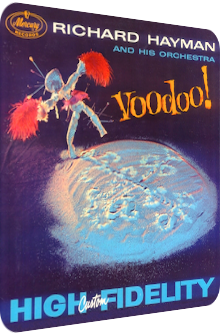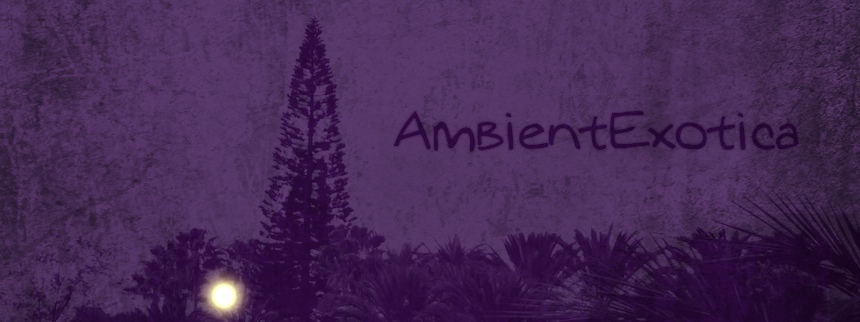
Richard Hayman
Voodoo!
1959
When Exotica and tiki aficionados hear the term voodoo, their eyes begin to sparkle, and rightfully so. Paradisiac panoramas and cherubic carefreeness make up the vast majority of the genre’s gold standards, but there is that darker side, murky enough to scare away the occasional listener who views the genre from an Easy Listening angle. Enter conductor, arranger and harmonica player Richard Hayman (born 1920) and his only, mercilessly exotic 12-track opus Voodoo!, recorded at Fine Recording Studios in New York and released in 1959 on the Mercury label. There is rarely a dull moment on this record which gyrates between melodious brass-fueled overtones and adamantly pompous drum erections of all kinds.
But wait a minute… isn’t there (at least) another well-known voodoo album? Indeed, there are many, but only one is the direct competitor of Richard Hayman. It is a sad sidenote in the history of Exotica that Robert Drasnin’s Voodoo! with the very same title, and released in the same year, is much, much better known than Richard Hayman’s viewpoint on the potentially dark topic. It is true that Drasnin’s album is one of the milestones of the Exotica genre, tremendously soothing, transformative and keen on taking the listener to beautiful gardens, nonhazardous jungles and letting him or her experience outright beautiful melodies of glaring insouciance, but Hayman’s version has its strong qualities as well and ventures into the wilder side of things, if only cautiously and temporarily so. It is strikingly brass-focused and hence sounds a bit more common or normal in lack of a better term, but the percussion aortas are also more in the foreground, oftentimes causing staggering revelations and cinematic coruscations. There is a certain wildness embroidered in the 12 sceneries, one whose overwhelming dimensions are diminished by warmhearted melodies. At least sometimes. Or occasionally. That’s what I hope. In the following paragraphs, I take part in the voodoo ritual and write about its stellar and dun peculiarities below.
Danse Calinda opens Richard Hayman’s voodoo curse. Hollowed holy halls, heavily reverberated bongo rhizomes, this is a nocturnal anacrusis alright… which immediately turns into daylight once the rufescent acoustic guitar billows and designedly cacophonous kazoo-like clarinet tones lead the way to equally silkened and euphonious brass layers. A grand shift in mere seconds! What starts shady becomes almost unbearably syrupy and fairy tale-evoking. Farting tubas and polyphonic xylophone driblets round off a piece which only succeeds due to its rhythm. Fortunately, Danse Calinda is indeed the only all too bright tune, everything else is much more sinister while still retaining magnanimous traces of that certain Hollywood sound.
Conjuration is much more polymorphous, probably because it is envisioned by Jim Tyler, but the definite reason could be based on many things. Pizzicato nylon guitar slaps, mysterious wind chimes and ranting tubas in tandem with delightfully pentatonic flute riverbeds create an echoey piece whose pointillistic stop-and-go motion and variety of textures make it a superbly dualistic ditty shuttling between pristine purity and sunset-red drum vistas. It is wise to possess the stereo version here, for the plasticity and wideness are a boon. One of my favorite takes of the album and a great Exotica song overall.
Spell Of Deatra is next, another successful composition which, yet again, is at first draped in an enigmatic veil of red brass blebs, vibraphone dots and a strikingly Oriental mirage before the scope widens and includes alto flutes, a gentle shrapnel of beaten bongos and short twangs of a real sitar. The intertwinement of the various surfaces works, and even the dark piano chords as well as the double bass accents are cleverly integrated, as the arrangement leaves room for them to shine due to its many interstices. The centerpiece of side A follows: Incantation is a mesmerizingly tribal take on the Exotica genre with a cavalcade of congas, boo-bams and drums, with its clinging tambourines and fizzling maracas in the limelight. African chants and a hyper-ritualistic interlude with a different tempo would even make Chaino and Sabu very proud. Here, for once, is a truthful faux-African take; I am aware of this description being a paradoxon, but it really fits the mercilessly dark scope of this composition.
And this is only the beginning, for Afro remains hued in sanguine colors, launching with earth-shattering drums, moving over to gypsy bonfire timbres via both the tremolo of the clarinet and the tambourine-infested brass stabs, and then finishing the wild ride off with a staccato scheme of bongos. This song fades out all too soon and is oddly moody, but a fitting inclusion in Hayman’s work nonetheless. The portentously titled Zombi finishes side A, a danger-evoking piece of muffled drums, pitch-black backdrops and trap-insinuating tone sequences on the brass instruments. Chinese gongs and indifferent flutes emend an adrenaline-boosting classic.
Side B is no different and offers ever-darkening compositions. The eponymous Voodoo is a highly melodramatic piece with mean-spirited horns, frightening drums and bejinxed Honky Tonk piano chords which gyrate around equally heftily orbiting xylophone specks and tambourine star dust. Even though the melody contains traces of Crime Jazz and thus glimpses of light, Voodoo lives up to the pompous majesty that is enforced on the vast majority of the tracks. Jim Tyler’s second take Mamba amplifies the cinematography even more with a bone-crushing drum chaparral, pre-Funk guitar slaps (it’s 1959 after all!) and histrionic flute vesicles. The short drum intermissions succeed with their punchy protrusions and make this another huge brute.
While Haiti offers a contraveningly bubbling vista of joyful melodies complete with rarely heard strings, downwards spiraling piano shards and cautious Dixieland vestiges, the polyhedron Midnight Ritual by Sticks Evans at first features orchestra bells, dubious reed melodies, a four-note bass aorta and conspirative legato horn washes before a short segue injects a tribal dose of saltatory frenzy which then leads the way to the known textural range. Even Gris-Gris can offer a new stylistic range of dissonant bass flute splinters, snake-evoking maraca protuberances and strangely falsetto-fied melodies, whereas Invocation is the breakneck conclusion to the album that enthralls with its tramontane flute solo, reaching the listener’s ears directly from the mountain range of Peru; naturally, the tempo and density of the percussion layers is soon increased and almost closes the album in a proper ritualistic way, for it is again the picturesque Maya flute tones that function as an encapsulation to the savage sorcery.
Richard Hayman’s Voodoo! is a fantastic – and to make things even better, a “no compromise” – addendum to Robert Drasnin’s Voddoo!, even though I have to admit that my comparison between these two works feels a bit forced and only came to be due to these LP’s being released in the same year and sharing titles that are completely identical. Heck, the similarity even goes so far as to include of the rude exclamation mark at their ends. Both works glorify and transmute the voodoo cult in the way Exotica artists tend to do, there is anything particularly real or faithful about the constructions unlike, say, Ti-Marcel’s and Ti-Roro’s Voodoo Drums In Hi-Fi (1958) which is recorded on site in Haiti and even features an ensemble of street musicians. But realness and the careful inclusion of traditions and reality ar normally not what Exotica is about. The artists rather create new forms of expression with well-known ingredients that appear in different contexts. In terms of Hayman’s Voodoo!, it is the delightful synergy of big band horns with Latin percussion, un soupçon de Dixieland and a cineastic scope. The opener Danse Calinda is the most gleeful and overall most disappointing inclusion of the record, and from this point onwards, it can only get better.
I am particularly fond of the well-balanced level of savage behavior, so to speak. Hayman’s arrangements are neither raucous enough to be on par with the aforementioned congueros Sabu and Chaino, nor clichéd enough to categorize them into the otherwise splendid genre called Space-Age. Ominous pieces like Midnight Ritual and Incantation are almost torn apart by the oomph of the forceful congas and bongos. Likewise, the trumpets and trombones cover all stages, from dreamy and soothing over playful and cheeky to fiery and incisive akin to Yma Sumac’s Mambo! (1954). Drasnin’s Voodoo! is the technicolor rain forest with no harm whatsoever. Hayman’s take is that of a tribe’s mad leader in charge of catapulting the sensory perception into previously unknown spheres, if necessary. And necessary it is. Time and again. Available on vinyl and a remastered download version on Amazon MP3, iTunes and related tribes.
Exotica Review 307: Richard Hayman – Voodoo! (1959). Originally published on Jan. 18, 2014 at AmbientExotica.com.
